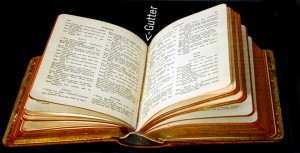Related Information
At first glance, the "gutter" as a technical term appears to be a rather humdrum and dull word, something so basic to be almost beneath notice. Noted bibliophile John Carter certainly seemed to think so:
"In normal bookseller's parlance this means the margin or space between the inner edges of two facing pages, a fact so obvious as to hardly justify notice" -- ABC for Book Collectors
College students will think of this blank space between the edges of the text on two facing pages as the margin in which it's very difficult to write notes -- while bibliophiles may cringe at the very idea.
Beware Things that Live in the Gutter
Margot Rosenberg warns that "In old books that have been neglected, the gutter can hold a tremendous amount of dirt, especially deep, where the pages meet." She advises a small brush or miniature vacuum cleaner to remove any debris.
So, the gutter is generally thought of as a necessary evil, an inconvenience, or simply the least-interesting part of a book.
The Gutter as a Printers’ Term
Carter went on to note that printers define the gutter slightly differently; to printers the gutter refers to "the wider space left in the FORME between the fore-edges of two abutting pages." (The FORME referred to is the prepared type, set type in a metal frame (the CHASE) from which the pages are imprinted.) So, Carter's interest in defining the gutter seems to have been in order to avoid confusion between its different meanings to printers and to book collectors.
While Carter is of course technically correct, a far-more-interesting consideration of the gutter can be found in the related world of comics theory.
The Gutter: The Very Heart of Comics
Scott McCloud defines the gutter in comics as the space between panels, an interstitial space where meaning is made by connecting the contents of one panel to the next:
"in the limbo of the gutter, human imagination takes two separate images and transforms them into a single idea." (Understanding Comics).
Taking this idea one step further, Katie Monnin has written that "the gutters that fall in between the panels are the 'glue-like' moments that bind the panels--and the story--together" (Teaching Graphic Novels).

(Image source: Understanding Comics by Scott McCloud)
This idea returns to the practical roots of the word as a bibliographic term, because if one follows the edges of the two facing pages down into the gutter (symbolically speaking, as this is beyond where the eye can see) you reach the point where the pages are bound together (nowadays most often with glue). In fact, the gutter is of prime importance to the book-restorer, whose all-but-invisible art often involves reattaching pages deep in the gutter.
Whether one can make the same grandiose claims for the gutter as the symbolic "glue" that makes meaning between one-page and the next for traditional books as Monnin makes for comics is debatable -- the comic being a form that raises brevity to a fine art, while the book allows for (and perhaps encourages) sustained and often tedious discussion (as any former graduate student can attest) -- but it's an attractive idea that may appeal to the romantic literary theorist in all of us.
And speaking of romantic literary icons, perhaps the last word should go to the great Oscar Wilde, although I don't think he was referring to a book's gutter when he memorably wrote:
“We are all in the gutter, but some of us are looking at the stars.” (Lady Windermere's Fan)
---
Featured image source: Brenda Clark, via a cc license from Flickr)
